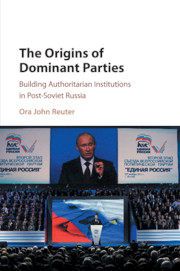Book contents
- The Origins of Dominant Parties
- The Origins of Dominant Parties
- Copyright page
- Contents
- Figures
- Tables
- Acknowledgments
- Abbreviations
- 1 Introduction
- 2 A Theory of Dominant Party Formation
- 3 False Starts: The Failure of Pro-Presidential Parties under Yeltsin
- 4 The Emergence of a Dominant Party in Russia: United Russia, Putin, and Regional Elites, 2000–2010
- 5 United Russia as the Dominant Party
- 6 United Russia and Russia’s Governors
- 7 Economic Elites and Dominant Party Affiliation
- 8 Dominant Party Emergence around the World
- 9 Conclusion
- References
- Index
- References
References
Published online by Cambridge University Press: 04 July 2017
- The Origins of Dominant Parties
- The Origins of Dominant Parties
- Copyright page
- Contents
- Figures
- Tables
- Acknowledgments
- Abbreviations
- 1 Introduction
- 2 A Theory of Dominant Party Formation
- 3 False Starts: The Failure of Pro-Presidential Parties under Yeltsin
- 4 The Emergence of a Dominant Party in Russia: United Russia, Putin, and Regional Elites, 2000–2010
- 5 United Russia as the Dominant Party
- 6 United Russia and Russia’s Governors
- 7 Economic Elites and Dominant Party Affiliation
- 8 Dominant Party Emergence around the World
- 9 Conclusion
- References
- Index
- References
Summary

- Type
- Chapter
- Information
- The Origins of Dominant PartiesBuilding Authoritarian Institutions in Post-Soviet Russia, pp. 283 - 300Publisher: Cambridge University PressPrint publication year: 2017



